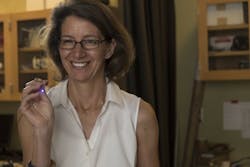Fluorescence microscopy software could yield faster breast cancer diagnosis
Bioengineers at Rice University (Houston, TX) have developed new fluorescence microscopy software that could speed diagnosis of breast cancer with 90-percent accuracy and at the point of care. Those involved in the work say the software could improve breast cancer management, particularly in developing countries where pathologists are not routinely available.
Related: New microendoscope doubles sensitivity of esophageal cancer screenings
Lead researcher Rebecca Richards-Kortum, Rice University's Malcolm Gillis University Professor and professor of bioengineering and electrical and computer engineering, says that she and her team have developed a faster means to classify benign and malignant human breast tissues using fresh samples, thereby removing the need for time-consuming tissue preparation.
When examined under a microscope, cancerous and precancerous cells typically appear different from healthy cells. The study of cellular structures is known as histology, and a histological analysis is typically required for an accurate diagnosis of both the type and stage of a cancerous tumor.
The software developed in Richards-Kortum’s lab allows for an automated histological assessment of breast cancer from tissue samples without the need for complex tissue-sample preparation or assessment by a pathologist. The software uses images from a confocal fluorescence microscope to analyze freshly cut human breast tissue samples for certain histological parameters that are typically used in breast cancer diagnosis. The software uses the parameter data to classify the tissue in each image and make a determination whether the imaged tissue is benign or malignant.
Although the software could have substantial clinical relevance, Richards-Kortum says more research and refinement of the classification procedures are needed before the software can be used in a clinical setting.
Full details of the work appear in the journal Breast Cancer Research; for more information, please visit http://dx.doi.org/10.1186/s13058-015-0617-9.
Follow us on Twitter, 'like' us on Facebook, connect with us on Google+, and join our group on LinkedIn

